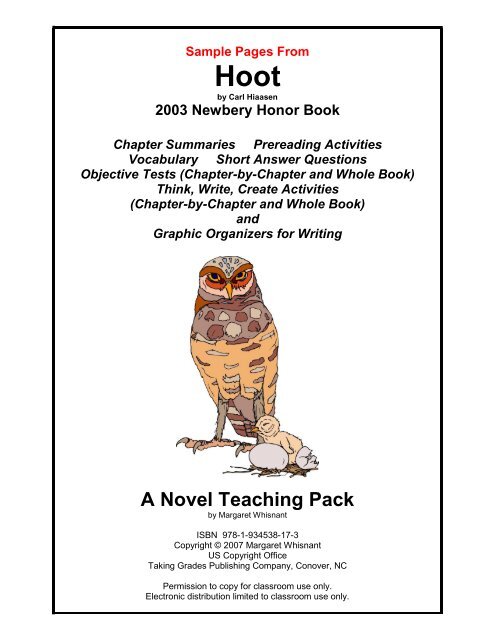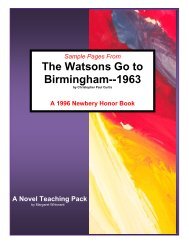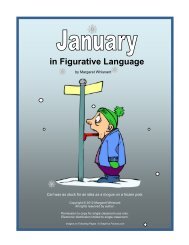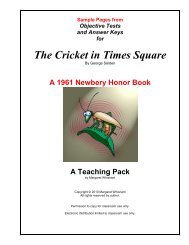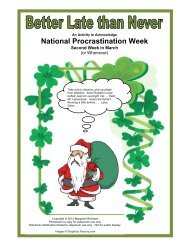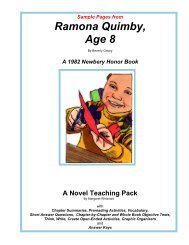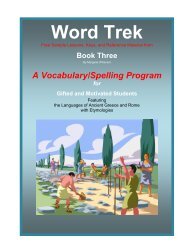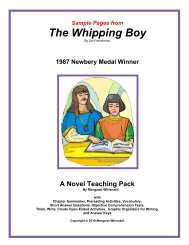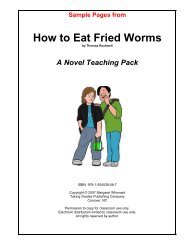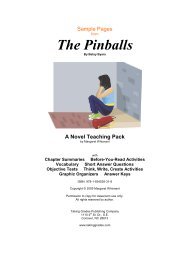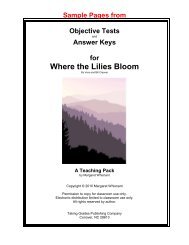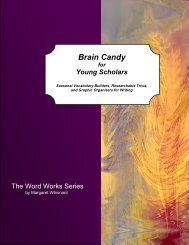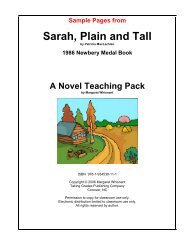Chapter-by-Chapter and Whole Book - Taking Grades Publishing ...
Chapter-by-Chapter and Whole Book - Taking Grades Publishing ...
Chapter-by-Chapter and Whole Book - Taking Grades Publishing ...
Create successful ePaper yourself
Turn your PDF publications into a flip-book with our unique Google optimized e-Paper software.
Sample Pages From<br />
Hoot<br />
<strong>by</strong> Carl Hiaasen<br />
2003 Newbery Honor <strong>Book</strong><br />
<strong>Chapter</strong> Summaries Prereading Activities<br />
Vocabulary Short Answer Questions<br />
Objective Tests (<strong>Chapter</strong>-<strong>by</strong>-<strong>Chapter</strong> <strong>and</strong> <strong>Whole</strong> <strong>Book</strong>)<br />
Think, Write, Create Activities<br />
(<strong>Chapter</strong>-<strong>by</strong>-<strong>Chapter</strong> <strong>and</strong> <strong>Whole</strong> <strong>Book</strong>)<br />
<strong>and</strong><br />
Graphic Organizers for Writing<br />
A Novel Teaching Pack<br />
<strong>by</strong> Margaret Whisnant<br />
ISBN 978-1-934538-17-3<br />
Copyright © 2007 Margaret Whisnant<br />
US Copyright Office<br />
<strong>Taking</strong> <strong>Grades</strong> <strong>Publishing</strong> Company, Conover, NC<br />
Permission to copy for classroom use only.<br />
Electronic distribution limited to classroom use only.
Copyright © 2007 Margaret Whisnant<br />
Hoot<br />
By Carl Hiaasen<br />
A Novel Teaching Pack<br />
By Margaret Whisnant<br />
All Rights Reserved <strong>by</strong> Author<br />
Permission to copy for classroom use only.<br />
ISBN 978-1-934538-17-3<br />
<strong>Taking</strong> <strong>Grades</strong> <strong>Publishing</strong> Company<br />
1110 4 th St. Dr., S.E.<br />
Conover, NC 28613<br />
www.takinggrades.com
Copyright © 2007 Margaret Whisnant<br />
Table of Contents<br />
3<br />
Hoot<br />
By Carl Hiaasen<br />
Page<br />
<strong>Chapter</strong> Summaries . . . . . . . . . . . . . . . . . . . . . . . . . . . . . . . . . . . . . . . . . . . . . . . . .1-18<br />
Before You Read . . . . . . . . . . . . . . . . . . . . . . . . . . . . . . . . . . . . . . . . . . . . . . . . . 19-20<br />
Vocabulary<br />
Definitions . . . . . . . . . . . . . . . . . . . . . . . . . . . . . . . . . . . . . . . . . . . . . . . . . . . . . . . 21-25<br />
Dictionary Digs. . . . . . . . . . . . . . . . . . . . . . . . . . . . . . . . . . . . . . . . . . . . . . . . . . . .26-33<br />
Word Construction . . . . . . . . . . . . . . . . . . . . . . . . . . . . . . . . . . . . . . . . . . . . . . . .34-35<br />
Stealth Words. . . . . . . . . . . . . . . . . . . . . . . . . . . . . . . . . . . . . . . . . . . . . . . . . . . . . . . 36<br />
Anagrams to Decipher. . . . . . . . . . . . . . . . . . . . . . . . . . . . . . . . . . . . . . . . . . . . . . 37-38<br />
Reading Assessment<br />
Short Answer . . . . . . . . . . . . . . . . . . . . . . . . . . . . . . . . . . . . . . . . . . . . . . . . . . .39-44<br />
Objective Tests . . . . . . . . . . . . . . . . . . . . . . . . . . . . . . . . . . . . . . . . . . . . . . . . . 45-77<br />
Think, Write, Create<br />
<strong>Chapter</strong> Activities . . . . . . . . . . . . . . . . . . . . . . . . . . . . . . . . . . . . . . . . . . . . . . . 78-91<br />
<strong>Whole</strong> <strong>Book</strong> Activities . . . . . . . . . . . . . . . . . . . . . . . . . . . . . . . . . . . . . . . . . . . .92-95<br />
Graphic Organizers . . . . . . . . . . . . . . . . . . . . . . . . . . . . . . . . . . . . . . . . . . . . . . 96-106<br />
Keys . . . . . . . . . . . . . . . . . . . . . . . . . . . . . . . . . . . . . . . . . . . . . . . . . . . . . . . . . . . 107-116
Summaries Hoot<br />
By Carl Hiaasen<br />
<strong>Chapter</strong> Summaries<br />
One<br />
Roy Eberhardt notices the strange boy running along beside the school bus because Dana<br />
Matherson grabs his head from behind, presses his thumbs into Roy’s temple, <strong>and</strong> smashes his<br />
face against the window.<br />
The running boy is not wearing shoes. Instead of boarding the bus as Roy expects, the boy turns<br />
off the sidewalk <strong>and</strong> runs across private yards until he disappears from view.<br />
No one helps Roy, the new kid, against Dana, a well-known idiot whose two main hobbies are<br />
smoking <strong>and</strong> beating up smaller kids. Dana outweighs Roy <strong>by</strong> at least fifty pounds.<br />
___________________________________________________________<br />
The same morning, police officer David Delinko is called to the construction site of another Mother<br />
Paula’s All-American Pancake House. Leroy Branitt, the supervising engineer, introduces himself<br />
as Curly. He complains that all the survey stakes have been pulled from the ground, thrown<br />
around, <strong>and</strong> the holes filled in.<br />
Returning to his patrol car, Officer Delinko steps in a hole <strong>and</strong> falls down. Curly explains that an<br />
owl about as tall as a beer can lives in it.<br />
Officer Delinko has difficulty filing his report because there has been no monetary damage <strong>and</strong><br />
technically no v<strong>and</strong>alism. Curly says that moving the survey stakes has screwed up the whole<br />
construction schedule. Both men think the mischief is the work of kids, though they don’t know<br />
why <strong>and</strong> have no suspects.<br />
Officer Delinko asks about the fate of the owls once the bulldozing starts. Curly answers, “What<br />
owls?”<br />
___________________________________________________________<br />
Roy, who has moved to Florida from Montana <strong>and</strong> is new at Trace Middle, does not see the<br />
running boy at school.<br />
Roy’s father works for the government. He is good at his job, he gets promoted, <strong>and</strong> the family<br />
moves around a lot. Trace Middle is the sixth school Roy has attended. Coconut Cove is the<br />
tenth town he can remember.<br />
Garrett, whose mother is a guidance counselor at Trace Middle, is a D student, goofs around in<br />
class, <strong>and</strong> is the school’s king of phony farts. He talks to Roy about skateboarding.<br />
Roy asks Garrett about the barefoot boy he saw, but Garrett’s only explanation is that the boy is<br />
either skipping class or he is a psycho.<br />
Roy suggests that maybe the boy is an outlaw. Garrett laughs. Roy is thinking about a plan to find<br />
the strange boy.<br />
Two<br />
The next morning on the bus, Roy sits close to the front door to watch for the boy. For three days<br />
there is no sign of the barefoot boy.<br />
By Friday, Roy is sitting ten rows from the door when the running boy reappears. Roy rises to run<br />
for the door as the bus approaches the intersection, but Dana grabs him <strong>by</strong> the throat from behind<br />
<strong>and</strong> begins choking him.<br />
In desperation, Roy clenches his right fist <strong>and</strong> brings it up over his shoulder as hard as he can.<br />
Dana’s h<strong>and</strong>s fall away from his neck.<br />
Roy bolts from the bus, edging past a tall girl with curly blond hair <strong>and</strong> red-framed eyeglasses.<br />
Roy exhausts himself chasing the running boy for several blocks, through a construction site, <strong>and</strong><br />
onto a golf course. The boy disappears into the pine trees on the edge of the golf course. Roy<br />
continues his pursuit but is hit in the head with a golf ball <strong>and</strong> knocked out.<br />
___________________________________________________________<br />
Though he was born in Detroit, Michigan, Roy tells everyone at Trace Middle School he is from<br />
Bozeman, Montana, where his family had lived for two years, seven months, <strong>and</strong> eleven days. It is<br />
Roy’s favorite of all the places his family has lived.<br />
Copyright © 2007 Margaret Whisnant<br />
1
Vocabulary Hoot<br />
By Carl Hiaasen<br />
Copyright © 2007 Margaret Whisnant<br />
Word Lists with Definitions<br />
(Arranged in Story Order)<br />
(Some words may appear on more than one page.)<br />
Set One: <strong>Chapter</strong>s 1-6<br />
malicious Full of, characterized <strong>by</strong>, or showing a desire to inflict harm, injury, or suffering on<br />
another, either because of hostile impulse or deep-seated meanness; spiteful;<br />
malevolent; hateful; wicked; baleful. (p. 7)<br />
sarcastically Spoken as a sneering or cutting remark, often tending to wound; in the manner of wit<br />
intended to make its victim the butt of contempt or ridicule; caustically; brusquely;<br />
mockingly. (p. 11)<br />
skeptical Having or showing doubt; questioning; disbelieving; agnostic; suspicious. (p. 12)<br />
chortled Gave a snorting, gleeful laugh or chuckle; guffawed; snickered. (p. 14)<br />
gout A spurt; a mass or splash, as of blood; an acute, recurrent disease characterized <strong>by</strong> painful<br />
inflammation of the joints, chiefly those in the h<strong>and</strong>s <strong>and</strong> feet. (p. 16)<br />
perpetually In a continuous, endless manner; happening for an indefinitely long period of time;<br />
continuing or continued without interruption; endlessly; unceasingly; repeatedly. (p. 18)<br />
unprovoked Occurred without cause or motivation; unnecessary; groundless; unjustified. (p. 18)<br />
menace Something that threatens to cause evil, harm, injury, etc.; a person whose actions,<br />
attitudes, or ideas are considered dangerous or harmful; nuisance; threat; danger. (p. 19)<br />
consternation A sudden, alarming amazement or dread that results in utter confusion; dismay;<br />
bewilderment; terror; fright; panic. (p. 20)<br />
intimidated Filled with fear; coerced, as if <strong>by</strong> threats; fearful; alarmed; terrified; frightened. (p. 22)<br />
snidely Done in a derogatory, nasty, insinuating manner; spoken in a maliciously superior way;<br />
hatefully; hurtfully; spitefully; sarcastically. (p. 22)<br />
reproachfully In a fault-finding, blaming, or censuring manner; in a manner expressing<br />
disapproval; in a scolding manner. (p. 23)<br />
methodically Performed, disposed, or acted in a systematic way; orderly; exactly; systematically;<br />
carefully. (p. 24)<br />
indignation Strong displeasure at something considered unjust, offensive, insulting, or base;<br />
righteous anger; resentment; exasperation. (p. 25)<br />
flabbergasted Overcome with astonishment; dumbfounded; astounded; befuddled; baffled. (p. 27)<br />
leniency The quality or state of being agreeably tolerant, permissive, or indulgent; the lack of<br />
harshness or strictness; clemency; forgiveness. (p. 28)<br />
deciphered Made out the meaning of, such as poor or partially obliterated h<strong>and</strong>writing; discovered<br />
the meaning of, as something difficult to trace or underst<strong>and</strong>; understood; decoded;<br />
deduced; unraveled. (p. 29)<br />
ferocious Savagely fierce, as a wild beast, person, action, or aspect; violently cruel; brutal. (p. 30)<br />
sinewy Having vigorous strength or muscular power; muscular; athletic; stalwart. (p. 30)<br />
contemplated Thought fully or thoroughly about; observed or studied thoughtfully; considered;<br />
pondered. (p. 32)<br />
intrigued Felt curiosity <strong>and</strong> interest, as in something unusual, new, fascinating, or with compelling<br />
qualities; captivated; attracted; charmed. (p. 40)<br />
culprit A person or other agent responsible for or guilty of an offense or fault; criminal; offender;<br />
transgressor. (p. 40)<br />
mused Thought or meditated in silence; contemplated; ruminated; pondered. (p. 41)<br />
despondently In a manner expressing profound hopelessness, dejection, discouragement, or<br />
gloom; despairingly; downheartedly; forlornly. (p. 43)<br />
seething In a state of agitation or excitement; surging or foaming as if boiling; furious; livid. (p. 44)<br />
errant Straying from the regular or proper course; erring; journeying or traveling, as a medieval knight<br />
in search of adventure; wayward. (p. 49)<br />
debris Trash; rubble; the remains of anything broken down or destroyed; Geology: an<br />
accumulation of loose fragments of rock. (p. 52)<br />
2
Vocabulary Hoot<br />
By Carl Hiaasen<br />
Dictionary Digs<br />
(Set One: <strong>Chapter</strong>s 1-6)<br />
Dig into a dictionary to answer the following questions about some challenging words from the first six<br />
chapters of Hoot. Write the letter of the correct answer in the blank before each item.<br />
______1. Something that would probably need to be deciphered is (A) gas flowing from a pump<br />
into a vehicle, (B) very poor h<strong>and</strong>writing, (C) a list of suspects in a criminal investigation.<br />
______2. In addition to the definition of a mass or splash, as of blood, gout also names (A) a type<br />
of l<strong>and</strong>form, (B) an ancient architectural form, (C) a painful disease of the joints.<br />
______3. A synonym for altercation is (A) fight, (B) metamorphosis, (C) variation.<br />
______4. Which phrase can be substituted for illuminated in the following sentence without<br />
changing its meaning? A lightning streak illuminated the night sky.<br />
(A) lit up, (B) split open, (C) suddenly appeared<br />
______5. The word sinewy is often used to describe (A) the contours of a geographic region, (B) a<br />
person’s physical build, (C) the tense atmosphere preceding an argument.<br />
______6. A malicious remark is one that is (A) humorous, (B) unclear, (C) hateful.<br />
______7. Which of the following could be the cause of consternation? (A) receiving an<br />
unexpected bad grade on a test, (B) learning that a scheduled test has been postponed,<br />
(C) studying for a test <strong>and</strong> making a 100.<br />
______8. What explanation is the best interpretation of the following sentence?<br />
A fan was almost hit <strong>by</strong> an errant throw from an outfielder.<br />
The outfielder’s throw (A) had an amazing amount of power behind it, (B) went the<br />
wrong way, (C) was an expression of frustration.<br />
______9. The best example of a commendable act is (A) finding a five dollar bill, (B) selling<br />
a valuable coin at a reduced price to a friend, (C) finding a lost wallet <strong>and</strong> returning it.<br />
_____10. An antonym of chortled is (A) wailed, (B) guffawed, (C) snickered.<br />
_____11. Which of the words below can be substituted for reproachfully in the following sentence<br />
so that it is changed to an opposite meaning?<br />
Mrs. DeLair listened to Dillon’s question <strong>and</strong> then answered reproachfully.<br />
(A) disapprovingly, (B) scathingly, (C) respectfully.<br />
_____12. The word indignation is a noun that names a strong feeling of anger toward something<br />
thought to be unjust. Which of the following words is an adjective that describes the<br />
same strong feeling? (A) indignantly, (B) indignant, (C) indignatious<br />
_____13. Which of the following phrases best illustrates the correct use of intrigued? (A) an<br />
intrigued missing masterpiece, (B) intrigued <strong>by</strong> his scenario of the crime, (C) fully<br />
intrigued in thought.<br />
_____14. The correct pronunciation of debris is (A) dә.brē′, (B) dî.brә′, (C) dụ.brē.<br />
_____15. Another way to describe someone who is flabbergasted is (A) anticipating, (B) amused,<br />
(C) dumbfounded.<br />
_____16. Is it OK to answer a teacher’s question sarcastically? (A) Certainly. It indicates that<br />
you know the correct answer. (B) No. Showing contempt will probably lead to trouble,<br />
(C) Sure. Teachers appreciate that sort of humor.<br />
_____17. A good example of something that is inevitable is (A) getting older each year, (B) buying<br />
a car, (C) riding a school bus, though not every day.<br />
Copyright © 2007 Margaret Whisnant<br />
3
Assessment Hoot<br />
Short Answer Questions By Carl Hiaasen<br />
Copyright © 2007 Margaret Whisnant<br />
Short Answer Questions<br />
One<br />
1. Where was Roy when he first saw the running boy?<br />
2. What was the odd thing about the boy?<br />
3. Why did Roy think that fighting back against Dana Matherson would be a waste of time?<br />
4. What problem brought Officer Delinko to the construction site of another Mother Paula’s All-<br />
American Pancake House the same morning Roy saw the running boy?<br />
5. What problem had the trespasser created for the construction site?<br />
6. How did Officer Delinko learn that there were owls living in holes in the ground on the property?<br />
7. Why did Roy’s family move a lot?<br />
8. Where had Roy lived before his family moved to Florida?<br />
9. What was ironic about the fact that Garrett’s mother was a guidance counselor at Trace Middle<br />
School?<br />
10. When he was unable to find the strange boy at school <strong>and</strong> Garrett had no information about<br />
him, what was Roy determined to do?<br />
Two<br />
1. What did Dana Matherson do when Roy rose to leave the bus <strong>and</strong> follow the barefoot boy?<br />
2. How did Roy get away from Dana?<br />
3. Why did Roy stop chasing the running boy?<br />
4. Of all the places where Roy <strong>and</strong> his family had lived, which one was his favorite?<br />
5. What did Roy say when his father reminded him that their move to Florida meant being close<br />
to Disney World?<br />
6. Why didn’t Miss Hennepin believe Roy when he said Dana had tried to strangle him?<br />
7. Why did Miss Hennepin warn that Roy’s parents might get a hospital bill in the mail?<br />
8. How did Miss Hennepin punish Roy for fighting on the bus?<br />
9. What did Miss Hennepin see when she looked at Roy’s neck?<br />
10. What did the tall blond girl with the red-rimmed glasses say to Roy about chasing the barefoot<br />
boy?<br />
4
Assessment Hoot<br />
Objective Tests By Carl Hiaasen<br />
Write the letter of the correct answer in the blank.<br />
Copyright © 2007 Margaret Whisnant<br />
One<br />
Pages 1-12<br />
______1. Why did Roy Eberhardt notice the strange boy running along side the school bus?<br />
(A) Dana Matherson was smashing his face against the window. (B) He was staring out<br />
the window trying to ignore Dana Matherson. (C)The other kids on the bus were<br />
laughing <strong>and</strong> pointing at him.<br />
______2. In addition to his straw-blond hair, his tanned skin, <strong>and</strong> his clothes, what odd thing did<br />
Roy notice about the boy? He (A) was running with a limp, (B) didn’t seem to know<br />
where he was going, (C) was not wearing shoes.<br />
______3. Which of the following was not true of Dana Matherson? He (A) was a well-known idiot<br />
who outweighed Roy <strong>by</strong> at least fifty pounds, (B) smoked cigarettes <strong>and</strong> beat up smaller<br />
kids, (C) was a new kid on the bus, just like Roy.<br />
______4. Why was Officer David Delinko called to the construction site of another Mother Paula’s<br />
All-American Pancake House the same morning Roy saw the strange boy? Someone<br />
had (A) v<strong>and</strong>alized one of the bulldozers with spray paint, (B) pulled up all the survey<br />
stakes, thrown them around, <strong>and</strong> filled in the holes, (C) stolen a box of tools.<br />
______5. Officer Delinko thought Leroy Branitt, who introduced himself as Curly, must have a<br />
good sense of humor because (A) he was as bald as a beach ball, (B) had a twinkle in<br />
his eye, (C) didn’t seem to be upset <strong>by</strong> the condition of the construction site.<br />
______6. Why did Officer Delinko have difficulty writing a report about what had happened at the<br />
construction site? (A) Neither man could determine the actual cost of the v<strong>and</strong>alism.<br />
(B) Because there was no monetary damage, the damage was not officially v<strong>and</strong>alism.<br />
(C) Whoever had been on the property had not taken anything.<br />
______7. According to Curly, what problem had been caused <strong>by</strong> the trespasser? (A) The whole<br />
construction schedule had been screwed up. (B) The construction company would have<br />
to pay a fine. (C) The work crew would have to miss a day’s pay.<br />
______8. How did Officer Delinko discover that there were owls living in holes in the lot where the<br />
pancake house was going to be constructed? (A) Curly started complaining about them.<br />
(B) He saw one of them flying into a hole. (C) He stepped into one of the holes <strong>and</strong> fell.<br />
______9. How big were the owls that lived in the holes? They were (A) about as large as a cat,<br />
(B) about as tall as a beer can, (C) between eighteen <strong>and</strong> twenty inches high.<br />
_____10. Before he left the construction site, what did Officer Delinko want to know about the<br />
owls? (A) how many of them lived in the lot, (B) why no one ever saw them, (C) what<br />
would happen to them once the bulldozing started.<br />
5
Assessment Hoot<br />
Objective Tests By Carl Hiaasen<br />
_____11. In Roy’s eyes, how were Montana <strong>and</strong> Florida different? (A) Florida was hot <strong>and</strong><br />
steamy. Montana was cool <strong>and</strong> down right cold, (B) Montana had steep craggy<br />
mountains that rose into the clouds. Florida was the flattest place he had ever seen.<br />
(C) Florida was crowded. Montana was wide open spaces.<br />
_____12. How many schools had Roy attended since he had been going to school? (A) Trace<br />
Middle was the sixth school. (B) He had been in twelve schools not counting Trace.<br />
(C) He had been at three schools before Trace.<br />
_____13. Roy’s father worked for (A) a construction company, (B) the government, (C) the city of<br />
Coconut Cove.<br />
_____14. What happened every time Roy’s father got a promotion? (A) He bought a bigger house<br />
for his family. (B) He was transferred. (C) He went to work for another company.<br />
_____15. Where were Roy <strong>and</strong> Garrett when they talked about skateboards <strong>and</strong> the strange boy?<br />
They were (A) on the bus, (B) on the playground before classes began, (C) in the<br />
school cafeteria.<br />
_____16. Which of the following was not true of Garrett? He (A) was a D student, (B) goofed<br />
around in class <strong>and</strong> was the king of phony farts, (C) was not popular at all.<br />
_____17. What was the ironic thing about Garrett? (A) He was probably one of the most<br />
intelligent people in Roy’s class. (B) His mother was a guidance counselor at Trace.<br />
(C) Most of the teachers liked him in spite of his bad behavior.<br />
_____18. Where did Garrett <strong>and</strong> his friends like to ride skateboards? (A) at malls, (B) on<br />
sidewalks <strong>and</strong> vacant lots, (C) on the paved playground after school was dismissed.<br />
_____19. What thought did Roy add to Garrett’s suggestion that the strange kid was either<br />
skipping school or he was a psycho? The boy was (A) a runaway, (B) a dropout,<br />
(C) an outlaw.<br />
_____20. Roy was determined to (A) find the running boy, (B) get a skateboard, (C) find<br />
someone who knew the strange boy.<br />
Copyright © 2007 Margaret Whisnant<br />
6
Think, Write, Create Hoot<br />
<strong>Chapter</strong> Activities By Carl Hiaasen<br />
Copyright © 2007 Margaret Whisnant<br />
Think, Write, Create<br />
<strong>Chapter</strong> Activities<br />
One<br />
Suppose you, like Roy, looked out the window of your bus as you rode to school one morning <strong>and</strong><br />
saw a barefoot boy running past.<br />
Would the presence of such a boy be considered a strange circumstance where you live? Why or<br />
why not?<br />
Would you talk to somebody about what you saw? Would you look at the incident as something<br />
really important or simply something interesting to talk about? Explain.<br />
Predict two facts that you believe Roy will later uncover about the running boy.<br />
Two<br />
On the first morning he was called to the Mother Paula’s construction site, Officer David Delinko<br />
<strong>and</strong> Curly had the following conversation:<br />
“It’s about those owls.”<br />
“Sure.”<br />
“What’s gonna happen to them?” Officer Delinko asked. “Once you start bulldozing, I mean.”<br />
Curly the foreman chuckled. He thought the policeman must be kidding. “What owls?” he said.<br />
Based on this short exchange, identify the person who cares about the owls.<br />
Which person doesn’t seem to get it?<br />
What motivation do you think might be driving the v<strong>and</strong>al into action? Explain how you<br />
reached your conclusion.<br />
___________________________________________________________<br />
The running boy managed to stay well ahead of Roy, who began gulping like a beached trout in his<br />
efforts to keep up.<br />
As runners, how would you classify Roy <strong>and</strong> the barefoot boy? Fair, Good, Excellent, Superior?<br />
Explain your thinking.<br />
Use the author’s description of the chase to draw a map of the route you imagine the runner took.<br />
What distance do you estimate Roy had run when he was hit <strong>by</strong> the golf ball?<br />
Roy told the kids at Trace Middle he was from Montana, although he had been born in Detroit,<br />
Michigan. To his way of thinking, he really didn’t have a hometown, but Bozeman, Montana, was his<br />
favorite of all the places he had lived. He had locked himself in his bedroom <strong>and</strong> cried the night his<br />
father announced they would be moving to Florida.<br />
How long have you lived in your town? Were you born there? How does your residency compare<br />
to the two years, seven months, <strong>and</strong> eleven days that Roy lived in Bozeman, Montana?<br />
What do you think of Roy’s statement about Disney World? What would be your attitude if your<br />
family moved close to the famous amusement park? What emotion do you imagine Roy was<br />
feeling when he lambasted the popular vacation destination?<br />
Could it be possible that it was the amount of time Roy had spent in Bozeman, Montana, rather<br />
than the place itself that Roy loved? Could it have been a combination of both? Explain.<br />
Find the definition for the word homesick. Was this Roy’s problem? Did Roy actually have a<br />
home to miss? Explain your thinking.<br />
7
Think, Write, Create Hoot<br />
<strong>Whole</strong> <strong>Book</strong> Activities By Carl Hiaasen<br />
Copyright © 2007 Margaret Whisnant<br />
Think, Write, Create<br />
<strong>Whole</strong> <strong>Book</strong> Activities<br />
Garrett was the first student at Trace Middle School who talked to Roy. He seemed to keep<br />
popping in <strong>and</strong> out of Roy’s life with just the needed information in tow. At the Mother Paula’s<br />
groundbreaking ceremony, he again proved his worthiness as a friend.<br />
Which three words from the list below would you choose to describe Garrett’s personality? Use<br />
Garrett’s actions, his conversations, <strong>and</strong> the definitions of the terms you choose as part of your<br />
explanation.<br />
friendly empathetic impish disruptive boisterous<br />
undisciplined humorous enthusiastic supportive naughty<br />
daredevil lawless happy immature disrespectful<br />
troublemaker likeable devious entertaining loveable<br />
Which three words do you think Garrett’s teachers would use to describe him? Explain your<br />
choices.<br />
Identify the three words Garrett’s mother would most likely attach to his personality <strong>and</strong> behavior.<br />
Support your choices.<br />
___________________________________________________________<br />
Kimberly Lou Dixon, a former Miss America runner-up, was an actress who dressed up like an old<br />
lady <strong>and</strong> did commercials for Mother Paula’s. She also made personal appearances for the company’s<br />
special occasions, such as the groundbreaking ceremony in Coconut Cove.<br />
If you were offered the chance to make commercials <strong>and</strong> special appearances for a company of<br />
your choice, what famous organization would you like to represent?<br />
What character do you think you could portray for the company?<br />
Do you have an idea for a commercial? Plan your acting career <strong>by</strong> making some notes <strong>and</strong> write<br />
a composition about A Commercial Star. (Note: This activity would definitely be more fun with a<br />
writing partner.)<br />
If you have access to the right electronic equipment, record your commercial <strong>and</strong> share it with your<br />
classmates.<br />
___________________________________________________________<br />
Curly Branitt did his best to do his job at the Mother Paula’s construction site. He took on alligators,<br />
snakes, rats, <strong>and</strong> Chuck Muckle. He left the comfort of his home to guard the property through the<br />
night. Things did not always go as Curly planned.<br />
Which of the following phrases do you think best applies to Curly’s efforts? Use story events to<br />
explain your choice.<br />
nervous Nellie<br />
bumbling idiot<br />
Inspector Jacques Clouseau clone<br />
Barney Fife wanna-be<br />
Superman under the influence of kryptonite<br />
Batty Batman<br />
(character or phrase of your choice)<br />
___________________________________________________________<br />
8
Think, Write, Create Hoot<br />
<strong>Whole</strong> <strong>Book</strong> Activities By Carl Hiaasen<br />
Copyright © 2007 Margaret Whisnant<br />
The Mother Paula’s V<strong>and</strong>al<br />
Officer David Delinko’s Story<br />
(A Group Project)<br />
To tell his story, Mr. Hiaasen used the point of view known as third-person omniscient, which allows the reader<br />
to st<strong>and</strong> outside the action <strong>and</strong> watch it unfold through the eyes <strong>and</strong> thoughts of the main character, Roy<br />
Eberhardt. The reader has access to information not available to all characters—Officer David Delinko, for<br />
instance.<br />
Imagine that Officer Delinko decided to write the same story from his point of view as a narrative in first<br />
person. His version of the events, of course, would be based on his experiences only.<br />
Using the outline below as a “chapter guide,” write another version of Hoot as seen through the eyes of Officer<br />
David Delinko. Include his observations, his thoughts, <strong>and</strong> conversations.<br />
If one group is to complete the whole project, choose a leader <strong>and</strong> then decide who will write which chapter.<br />
Share <strong>and</strong> compare your account of The Mother Paula’s V<strong>and</strong>al with other class groups.<br />
If you are part of a group assigned to write one chapter, determine the writers, the editors, proofreaders,<br />
illustrators, etc. Then combine your chapter with the other six written <strong>by</strong> your classmates to form a complete<br />
story.<br />
I. <strong>Chapter</strong> One: Mother Paula’s IV. <strong>Chapter</strong> Four: I Capture the V<strong>and</strong>al<br />
A. The first two visits to the site A. The arrest<br />
1. The foreman <strong>and</strong> the damage 1. Circumstances<br />
2. The owls 2. Curly<br />
3. The alligators 3. The kid<br />
B. The police chief gets involved B. I am taken off desk duty<br />
C. I volunteer for patrol C. My suspicions<br />
1. Career goals/detective 1. Dana’s intelligence/lack of humor<br />
2. The v<strong>and</strong>al strikes 2. The green shirt<br />
3. The aftermath D. A visit to juvenile detention<br />
1. The rubber alligator<br />
2. My suspicions are confirmed<br />
II. <strong>Chapter</strong> Two: Roy Eberhardt<br />
A. I meet Roy Eberhardt<br />
1. The missing boy V. <strong>Chapter</strong> Five: The Groundbreaking Ceremony<br />
2. The rain A. The night before<br />
3. The bicycle 1. The owls<br />
4. I enlist his help 2. The white flashes<br />
B. Mr. <strong>and</strong> Mrs. Eberhardt B. Roy Eberhardt <strong>and</strong> the boy in the owl hole<br />
1. The letter 1. I refuse to arrest the boy<br />
2. Mrs. Eberhardt’s comments a. I meet the real v<strong>and</strong>al<br />
C. I Check the construction site b. The bucket of snakes<br />
1. The Rottweilers C. The owls are saved<br />
2. The owls 1. Chuck Muckle crumbles<br />
3. The green cloth on the fence 2. Mother Paula gives up<br />
4. The three kids <strong>and</strong> the bicycle<br />
VI. <strong>Chapter</strong> Six: Detective Delinko<br />
III. <strong>Chapter</strong> Three: The Runaway A. Dana Matherson Escapes<br />
A. I visit the Eberhardts 1. The arrest<br />
1. The kids 2. The boy who got away<br />
2. The bicycle B. Another commendation<br />
B. The phone call C. A bright future in Coconut Cove<br />
C. At the Emergency Room 1. Looking back<br />
1. Roy 2. Detective Delinko<br />
2. The missing kid<br />
3. The green shirt on my antenna<br />
D. My interpretation of the events<br />
___________________________________________________________<br />
9
Think, Write, Create Hoot<br />
Graphic Organizer #7 By Carl Hiaasen<br />
Will the Real Beatrice Please St<strong>and</strong> Up?<br />
Some of her classmates knew her as “Beatrice the Bear.” With her stepbrother, Roy, <strong>and</strong> the owls, she was “Beatrice the Teddy Bear.”<br />
Somewhere inside the bundle of contradictions was the real Beatrice.<br />
In one of the owl eyes below, write Beatrice the Bear. On the radiating lines, list behaviors that indicate her aggressive nature. In the<br />
second eye, write Beatrice the Teddy Bear. Use the connecting lines to enter facts that substantiate the soft side of Beatrice’s personality.<br />
Use your notes to write a composition entitled Will the Real Beatrice Please St<strong>and</strong> Up? In the last paragraph, identify the authentic<br />
Beatrice.<br />
Copyright © 2007 Margaret Whisnant<br />
10


